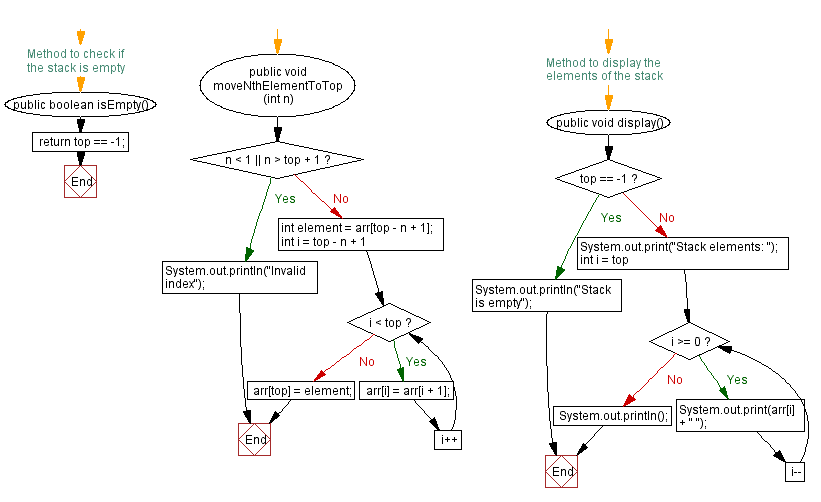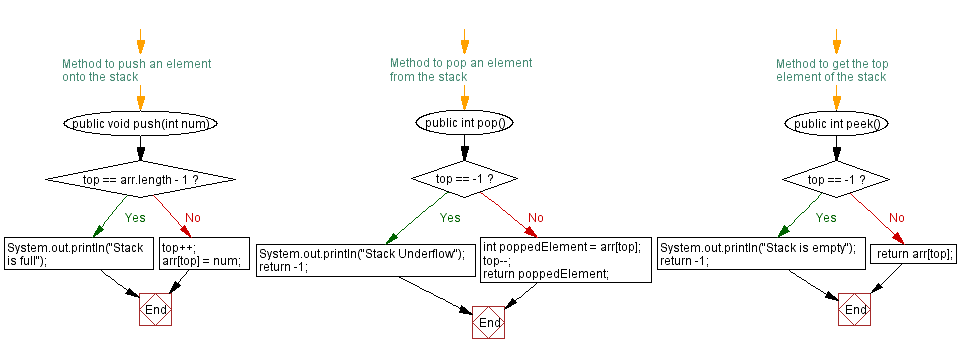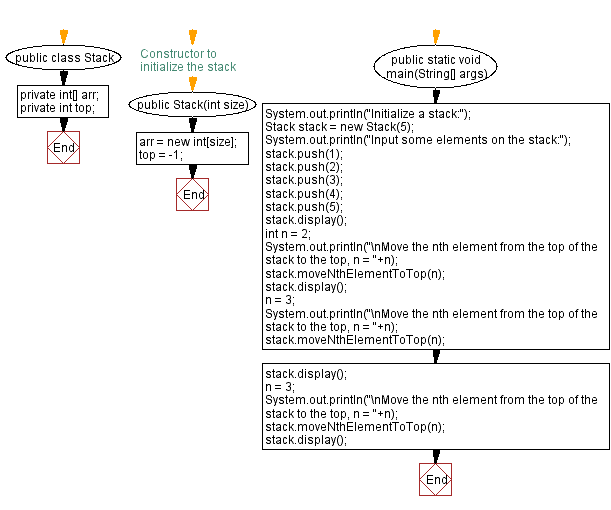Java: Move the nth element from the top of the stack to the top
17. Move the nth element from the top to the top.
Write a Java program to implement a stack and move the nth element from the top of the stack to the top.
Sample Solution:
Java Code:
import java.util.Scanner;
public class Stack {
private int[] arr;
private int top;
// Constructor to initialize the stack
public Stack(int size) {
arr = new int[size];
top = -1;
}
// Method to push an element onto the stack
public void push(int num) {
if (top == arr.length - 1) {
System.out.println("Stack is full");
} else {
top++;
arr[top] = num;
}
}
// Method to pop an element from the stack
public int pop() {
if (top == -1) {
System.out.println("Stack Underflow");
return -1;
} else {
int poppedElement = arr[top];
top--;
return poppedElement;
}
}
// Method to get the top element of the stack
public int peek() {
if (top == -1) {
System.out.println("Stack is empty");
return -1;
} else {
return arr[top];
}
}
// Method to check if the stack is empty
public boolean isEmpty() {
return top == -1;
}
public void moveNthElementToTop(int n) {
if (n < 1 || n > top + 1) {
System.out.println("Invalid index");
} else {
int element = arr[top - n + 1];
for (int i = top - n + 1; i < top; i++) {
arr[i] = arr[i + 1];
}
arr[top] = element;
}
}
// Method to display the elements of the stack
public void display() {
if (top == -1) {
System.out.println("Stack is empty");
} else {
System.out.print("Stack elements: ");
for (int i = top; i >= 0; i--) {
System.out.print(arr[i] + " ");
}
System.out.println();
}
}
public static void main(String[] args) {
System.out.println("Initialize a stack:");
Stack stack = new Stack(5);
System.out.println("Input some elements on the stack:");
stack.push(1);
stack.push(2);
stack.push(3);
stack.push(4);
stack.push(5);
stack.display();
int n = 2;
System.out.println("\nMove the nth element from the top of the stack to the top, n = " + n);
stack.moveNthElementToTop(n);
stack.display();
n = 3;
System.out.println("\nMove the nth element from the top of the stack to the top, n = " + n);
stack.moveNthElementToTop(n);
stack.display();
n = 3;
System.out.println("\nMove the nth element from the top of the stack to the top, n = " + n);
stack.moveNthElementToTop(n);
stack.display();
}
}
Sample Output:
Initialize a stack: Input some elements on the stack: Stack elements: 5 4 3 2 1 Move the nth element from the top of the stack to the top, n = 2 Stack elements: 4 5 3 2 1 Move the nth element from the top of the stack to the top, n = 3 Stack elements: 3 4 5 2 1 Move the nth element from the top of the stack to the top, n = 3 Stack elements: 5 3 4 2 1
Flowchart:



For more Practice: Solve these Related Problems:
- Write a Java program to remove the nth element from the top of a stack and then push it back to the top using an auxiliary structure.
- Write a Java program to implement a method that rotates the nth element from the top to the top by performing a series of pop and push operations.
- Write a Java program to recursively move the nth element from the top of a stack to the top while preserving order.
- Write a Java program to combine two stacks to reposition the nth element from the top to the top.
Go to:
PREV : Get the nth element from the bottom of the stack.
NEXT : Merge two stacks into one.
Live Demo:
Java Code Editor:
Improve this sample solution and post your code through Disqus
What is the difficulty level of this exercise?
Test your Programming skills with w3resource's quiz.
